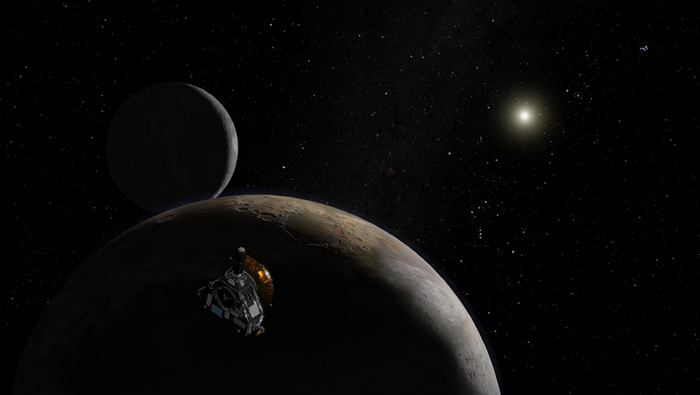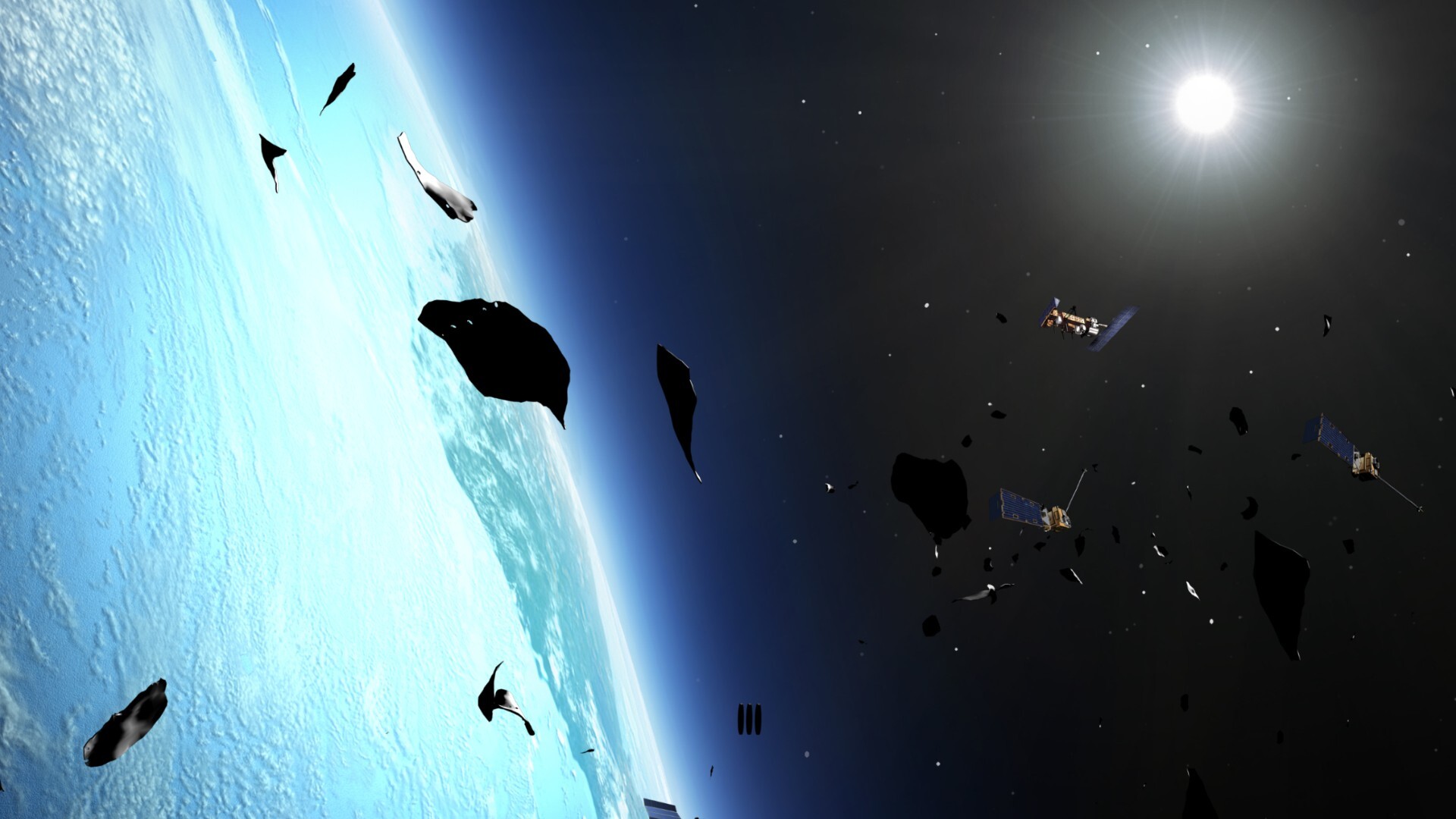New Horizons: Voyage To The Edge Of The Solar System

BOULDER, Colorado - NASA's New Horizons spacecraft is nearing a liftoff into the unknown. This first mission to Pluto and the Kuiper Belt--a distant district of ancient, icy, rocky objects on the solar system's outer banks--is assured to transmit back to Earth numbers of revelations.
Now being groomed for sendoff from Cape Canaveral Air Force Station in Florida, New Horizons has a 35-day launch window that opens January 11, 2006. The probe would start a decade of cruising to reach the Pluto system, arriving on the scene as early as summer 2015.
Getting a spacecraft en route to Pluto has not been easy. The march to that remote world has been dogged by budget battles, funding slashes, start-and-stop mission planning and hardware building.
But now the Pluto-bound craft is assembled, tested, and primed for an extraordinary expedition to the edge of the solar system.
Scientific surprises
Along with the spacecraft, also undergoing final prep is the New Horizons booster: A Lockheed Martin Atlas 5 first stage with five strap-on solid rocket boosters, a powerful Centaur second stage, topped by a STAR 48B solid propellant-fueled third stage.
The New Horizons spacecraft is roughly 8 feet (2.5 meters) across and weighs roughly 1,025 pounds (465 kilograms)--about half a ton--when loaded with fuel. The Department of Energy will supply the interplanetary probe with its power source, a single radioisotope thermoelectric generator (RTG).
Breaking space news, the latest updates on rocket launches, skywatching events and more!
Even before New Horizons rockets off Earth, Pluto has done its best to keep scientists guessing about the far-flung planet and Charon, a companion moon. Last month, NASA announced that the Hubble Space Telescope had observed that Pluto may have not one, but three moons.
New moons
Hubble's Advanced Camera for Surveys spotted the two candidate moons earlier in the year. The applicants for new moon-status are roughly 5,000 times fainter than the planet they orbit.
"I'm calling the discovery of the two new satellites the first scientific result of New Horizons," said Alan Stern, principal investigator for the mission here at the Department of Space Studies of the Southwest Research Institute (SwRI). The Hubble observations were done in support of the mission, he told SPACE.com.
Ground telescopes have long tried to scan for new moons around Pluto, Stern said. It took all of two eight-minute integration sessions for the space-based telescope to snag the objects.
Stern said that Hubble will be utilized again in February to scan for additional moons around Pluto. "One question that is on the table is just how many more little satellites are lurking there," he added.
Rings around Pluto?
And there could be yet another surprise awaiting New Horizons.
Calculations done by Stern and fellow researchers show that small moons around Pluto--having low escape speeds--when hit by objects not only are craters formed, but debris from the moons would be tossed off into space.
"We're predicting that Pluto might have a ring system," Stern said. "We're going to plan observations with New Horizons to look for those."
Given new moons, a possible ring system--Pluto and its environs are ripe for up-close surveillance, Stern said. "In my wildest dreams...I hoped to get four objects on this mission...Pluto, Charon, and one or more Kuiper Belt Objects. Now I get four, right at Pluto."
New Horizons sports a flexible set of instruments, set on discovery mode. That equipment will also be on the lookout for hazards. "We're also going to be using Hubble and other tools here on Earth for the next 10 years...to get a head's up about things long before we get there," Stern said.
Suite of seven instruments
The cost of the mission, including the launch vehicle and operations through the Pluto-Charon encounter, will be roughly $650 million.
Assuming liftoff during the primary launch window in January, the first 13 months include spacecraft and instrument checkouts, instrument calibrations, trajectory correction maneuvers. Spacecraft operators will also be rehearsing an encounter with Jupiter, slated to occur between February 25 and March 2, 2007.
Once en route, data sent from New Horizons will be received on Earth through NASA's Deep Space Network, dispatched onward to the spacecraft's Mission Operations Center at Johns Hopkins University Applied Physics Laboratory (APL) in Laurel, Maryland. APL manages the mission for NASA and built the New Horizons spacecraft. A radio signal moving at the speed of light takes about four hours to reach Pluto from Earth.
New Horizon carries a suite of seven scientific instruments:
- Alice is an ultraviolet spectrometer used for measuring gas composition
- Ralph combines an infrared spectrometer (LEISA) for mapping surface composition with a color optical imager (MVIC) for mapping surface structure and composition
- REX is a radio experiment for measuring atmospheric composition and temperature
- LORRI is an optical telescope that provides the highest resolution imaging of the surface
- PEPSSI is a plasma-sensing instrument for measuring particles escaping from Pluto's atmosphere
- SWAP is a plasma-sensing instrument for measuring the properties of the solar wind at Pluto, Pluto's atmospheric escape rate, and for searching for a magnetosphere around Pluto. The "solar wind" is a stream of charged particles streaming away from the Sun at high speed.
- SDC, an instrument used to measure dust impacts at the New Horizons spacecraft during its entire trajectory, was built by students at the University of Colorado in Boulder.
New Horizons is outfitted with a compact nuclear power system. The hardware converts the heat generated from the natural decay of radioactive fuel into electricity. The RTG consists of two major elements: a heat source that contains plutonium dioxide in the form of ceramic pellets and a set of solid-state thermocouples that convert the plutonium's heat energy to electricity.
Like any NASA mission designed to use an RTG, New Horizons has undergone extensive, multi-agency safety and risk reviews throughout its development. Final approval to launch, however, will come from the White House Office of Science and Technology Policy.
SwRI's Stern said that the New Horizon RTG has been tested. "We put it on the spacecraft to make sure that everything is mounted correctly. We turned on the spacecraft...ran all the instruments...for a number of hours to make sure that there were no surprises ahead," he explained.
One slight glitch in readying the booster for New Horizons was brought about by Mother Nature's fury.
Winds whipped up by a hurricane that struck Florida caused a door on the rocket's garage-like vertical hangar to bend inward. That section of door contacted the only solid rocket motor attached to the booster at the time.
Stern said that the "safest, most conservative" decision was made not to re-qualify for flight that motor. Rather, a spare was brought in to replace the unit. "They switched it out. Now all the other solid rocket boosters are there...and hurricane season is over!"
Getting the goods
For Stern, New Horizons and its mission have been a long time coming.
"It's awe inspiring, no question. The United States is going to the Kuiper Belt. We are launching to the edge of the solar system. It's like something out of a story book," Stern said.
But if there is a moral to this space story book it's that persistence is a virtue, Stern explained. It look a lot of perseverance on the part of the scientific community to come back time and time again when Pluto missions would fall apart at the seams, he added.
Now with launch less than 50 days away, the mission of New Horizons and its lengthy flight toward Pluto rapidly approaches.
"We don't succeed unless we get the goods at Pluto," Stern admitted. "Simply launching is not a mission success...but it is one hell of a major milestone."

Leonard David is an award-winning space journalist who has been reporting on space activities for more than 50 years. Currently writing as Space.com's Space Insider Columnist among his other projects, Leonard has authored numerous books on space exploration, Mars missions and more, with his latest being "Moon Rush: The New Space Race" published in 2019 by National Geographic. He also wrote "Mars: Our Future on the Red Planet" released in 2016 by National Geographic. Leonard has served as a correspondent for SpaceNews, Scientific American and Aerospace America for the AIAA. He has received many awards, including the first Ordway Award for Sustained Excellence in Spaceflight History in 2015 at the AAS Wernher von Braun Memorial Symposium. You can find out Leonard's latest project at his website and on Twitter.
